Below you will find a summary of all We Hear You Now stories and poems, with each piece also available in full as captioned audio.
The writers who have created the We Hear You Now series have provided some background to the inspirations and any historical sources or references behind the work.
You can also listen on Soundcloud.
Listen to the works
-
We Hear You Now – An Introduction by Alinah Azadeh
Listen to an introduction to We Hear You Now in full here (with audio captions):
You can also hear an introduction to We Hear You Now in the landscape that inspired it, owned and cared for by Seven Sisters Country Park. Access the visitor leaflet here.
What 3 Words: https://what3words.com/reading.whisker.arranged and https://what3words.com/soups.remake.geese
Writer Notes
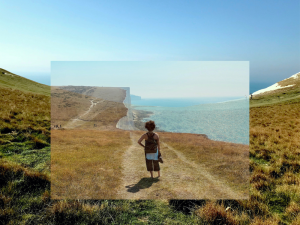
Photo by Lillana Gibbs. Remix by Jade Hylton.
Thanks to all the many staff, rangers, members and specialists at Seven Sisters Country Park, and across South Downs National Park Authority (SDNPA), and the National Trust South Downs East ranger team who gave me / us their time, knowledge, archival information and insights. Thanks also to: Anooshka Rawden (SDNPA), John Sygrave (Archaeology South-East), Chris Fairbrother (SDNPA climate & biodiversity) and Jo Seaman (Wildwood Heritage CIC) for the journeys back in time and to Colour Green/ Julie’s Bicycle for a grounding in climate justice issues.
Thanks to our main editor, novelist Umi Sinha. To our speculative fiction inspiration Leone Ross, to Corinne Fowler’s seminal book Green Unpleasant Land – Creative Responses to Rural England’s Colonial Connections, Anita Sethi’s We Belong Here and Adrienne Maree Brown’s Emergent Strategy
To Inscribe, New Writing South, Writing Our Legacy and to Colin Grant / WritersMosaic for advocacy, belief and support. To Jenny Wistreich and to Carolyn McCourt for the welcome and insight.
And to SDNPA and Arts Council England for the long-haul support and funding.
Thanks to all the We See You Now writers and allies, who agreed to explore and re-story the land together, and who made all of this possible.
-
We Hear You Now – Prologue by Alinah Azadeh
Listen to We Hear You Now – Prologue in full here (with audio captions):
You can also hear an introduction to We Hear You Now – Prologue in the landscape that inspired it, owned and cared for by Seven Sisters Country Park. Access the visitor leaflet here.
What 3 Words: https://what3words.com/skim.passage.visions
Summary
An encounter in 2053 between a young traveller and the chalk cliffs brings an unexpected change in the landscape.
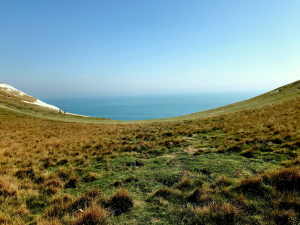
Photo by Nick Atkins.
Writer Notes
A prologue to the 13-part audio tour, first begun in 2019 at Birling Gap, this story sparked the entire project of walking and re-storying the land with other writers through and beyond the pandemic during our We See You Now programme and as part of my writer residency at Seven Sisters Country Park.
The refrain Baraye Azadi is inspired by Shervin Hajipour / Woman Life Freedom Movement. The language is Farsi, used by Persian people in Iran, Afghanistan and Tajikistan, and across the globe.
-
Precipice by Georgina Aboud
Listen to Precipice in full here (with audio captions):
You can also hear Precipice in the landscape that inspired it, owned and cared for by Seven Sisters Country Park. Access the visitor leaflet here.
What 3 Words: https://w3w.co/securing.picnic.perfectly
Summary
A young biologist examines Cuckmere’s history and speculative future under the shadow of climate change.
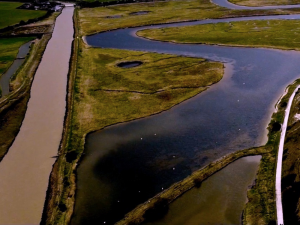
Photo by Nick Atkins.
Writer Notes
Through the course of writing ‘Precipice’, I stumbled upon the what3words geocode system ( https://what3words.com/pretty.needed.chill). What3words maps every 3-metre square of the world with a unique combination of three random words. This became the entry point to the piece and links the contrasting central ideas: the local and the global, the historical and a close speculative future.
The work draws on sources including the New Scientist, and the Victorian Studies Journal with Heidi Scott’s ‘Industrial Souls: Climate Change, Immorality, and Victorian Anticipations of the Good Anthropocene’. The Smithsonian Magazine’s commentary on a recent study examining at-risk African Heritage coastal sites was also helpful. Scientists examined the vulnerability of 284 heritage sites along Africa’s 300,000 kilometre coastline, revealing that at least 56 of the sites are already at risk from flooding and erosion. This number will triple to almost 200 by the year 2100, if climate change continues unchecked.
Closer to home, the piece was informed by Brighton Museum, the Women of Eastbourne project, Kevin Gordon, and the time, knowledge and patience of Alinah Azadeh, Anooshka Rawden, Sam Cordery and Leone Ross. .
Finally, in the way that art borrows from life and life reflects it back, in March 2023 the Intergovernmental Panel on Climate Change (IPCC) published a report detailing all human knowledge on the climate emergency. It took hundreds of scientists eight years to assemble and runs to thousands of pages but its message contained one central tenet: we are now on the brink of irrevocable damage, we need to act, or it will be too late.
-
Valley of Dreams by Razia Aziz
Listen to Valley of Dreams in full here (with audio captions):
You can also hear Valley of Dreams in the landscape that inspired it, owned and cared for by the National Trust. Access the visitor leaflet here.
What 3 Words: https://w3w.co/prompt.developer.cluttered
Summary
A new myth about the origins of the Cuckmere River, valley floor and estuary, interweaving Urdu, Hindi and English.
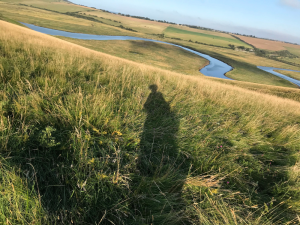
Writer Notes
This is a new myth of the Cuckmere Valley. It brings both spoken and sung strands in Urdu language, weaving them into the English text and into the landscape and a new myth of its origination. The centring of a divine entity originating in the Indian subcontinent in the story invites the reader/listener to see, hear and sense other possible worlds, epochs, sounds and meanings, during their exploration of the landscape of the Valley.
It uses short excerpts of four songs (in order below) that are known in the public domain in India and/or Pakistan and their diaspora.
- Mujhe tum nazar se giraa to rahe ho sung by Mehdi Hassan, Pakistani movie Doraha, 1967
- Aye kaash ke soz-e-gham ashko(n) mai(n) na dhal jaye lyric is a poem by Govind Rajasthani, melody by Sadat Ashraf
- Aye dil-e-naadaan sung by Lata Mangeshkar in the Indian movie Razia Sultan (1983). Poet: by Jan Nisar Akhtar (1976)
- Phool hi phool khil uthe by Mehdi Hassan. Several recorded versions from 1970s onwards.
-
Whitehawk Woman at Cuckmere Haven by By Joyoti Grech Cato
Listen to Whitehawk Woman at Cuckmere Haven in full here (with audio captions):
You can also hear Whitehawk Woman at Cuckmere Haven in the landscape that inspired it, owned and cared for by Seven Sisters Country Park. Access the visitor leaflet here.
What 3Words:
https://w3w.co/divisible.gender.blubber
Summary
Our Neolithic ancestor stands watch over the land and the People as we walk through time’s spiral.
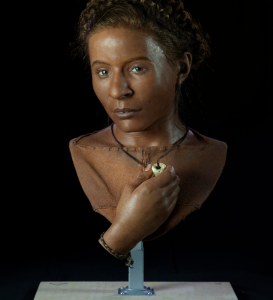
Photo by Oscar D. Nilsson (courtesy of Royal Pavillion and Museums, Brighton)
Writer Notes
In 2016, Brighton Museum started displaying a reconstruction of a young woman who lived in Neolithic times on or near Whitehawk Hill, East Brighton. As with Cheddar Man, her life is evidence of the diversity of ancient britons.
With thanks to Dave Bangs for his guidance and for his seminal book, ‘Whitehawk Hill, where the turf meets the surf’ (Friends of Whitehawk Hill, 2004).
With thanks to Brighton Museum and Art Gallery for use of the photo of Whitehawk Woman.
-
The Twilight Portal by Akila Richards
Listen to Twilight Portal in full here (with audio captions):
You can also hear Twilight Portal in the landscape that inspired it, owned and cared for by the National Trust. Access the visitor leaflet here.
What 3 Words:
https://w3w.co/melt.perkily.redeemed
Summary
Grandmother and granddaughter walk through a twilight portal that changes them and the landscape forever.
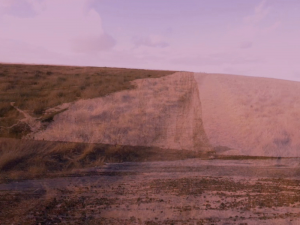
Photo by Bip Mistry
Writer Notes
The Twilight Portal is dreaming our bodies into the landscape. In the deeper layers, it is an intergenerational story spanning from the ancestral to futurity and how we exist in the twilight. It is the profound revealing of a truth, laid to rest for a new reality in a changed landscape.
This work was inspired by the 1747 wreck of the Nympha Americana along the shores of the Seven Sisters.
References:
- Things Fall Apart, the debut novel by Nigerian author Chinua Achebe, first published in 1958. It depicts pre-colonial life in the south-eastern part of Nigeriaand the invasion by Europeans during the late 19th century.
To find out more about the Nympha Americana, visit the following sites:
- Royal Museums Greenwich: Print by John Henry Hurdis showing the immediate aftermath of the wreck.
- Blogpost from Quirky Sussex History by Kevin Gordon: Quicksilver and Lemons (posted 29 November, 2020)
-
Cosmic Walker by Georgina Parke
Listen to Cosmic Walker in full here (with audio captions):
You can also hear Cosmic Walker in the landscape that inspired it, owned and cared for by Eastbourne Borough Council. Access the visitor leaflet here.
What 3 Words:
https://w3w.co/stag.double.ignites
Summary
An intimate walk in the dark along the chalkland coast from Birling Gap towards Beachy Head carries the listener into other worlds.
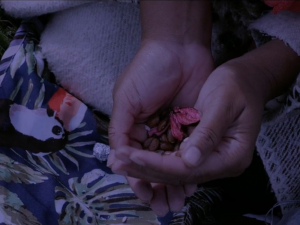
Photo by Bip Mistry
Writer Notes
The Kármán line is an attempt to define a boundary between Earth’s atmosphere and outer space and offers a specific definition set by the Fédération aéronautique internationale, an international record-keeping body for aeronautics.
-
The Dubious Tour by Jenny Arach
Listen to The Dubious Tour in full here (with audio captions):
You can also hear The Dubious Tour in the landscape that inspired it, owned and cared for by Eastbourne Borough Council. Access the visitor leaflet here.
What 3 Words:
https://w3w.co/activates.sweeping.linen
Summary
A bus and life journey with an English working class and African heritage poet, along the coast from Eastbourne to Seaford.
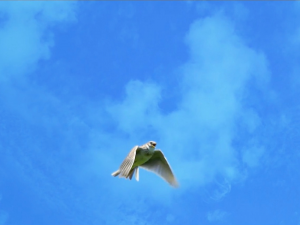
Photo by Big Wave TV
Writer Notes
‘Bwaga Moyo’ means ‘Lay down your Heart’ in Swahili.
It is disputed whether this refers to the slave trade which passed through the town (i.e. “give up all hope”) or to the porters who rested in Bagamoyo after carrying 16-kilogram (35 lb) cargoes on their shoulders from the Great Lakes region (i.e. “take the load off and rest”).
Musical Inspirations
- Miriam Mikaba – ‘ Nakupenda Malaika’ ( I Love You Angel). Listen on youtube.
- Docteur Nico & Orchestre African Fiesta : ‘Kiri Kiri Mabina Ya Sika’ ( ‘Kiri Kiri the New Dance’) Listen on youtube.
-
Missing on Seven Sisters by Oluwafemi Hughes
Listen to Missing on Seven Sisters in full here (with audio captions):
You can also hear Missing on Seven Sisters in the landscape that inspired it, owned and cared for by Seven Sisters Country Park. Access the visitor leaflet here.
What 3 Words:
https://w3w.co/marmalade.saying.racing
Summary
A daughter of the earth and of African and Asian heritage explores loss and reclamation, inspired by the Seven Sisters cliffs.
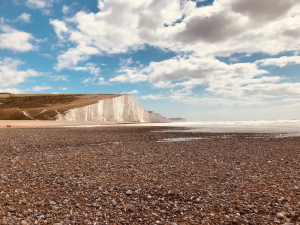
Photo by Alinah Azadeh
-
If You Can Imagine by Alinah Azadeh
Listen to If You Can Imagine in full here (with audio captions):
You can also hear If You Can Imagine in the landscape that inspired it, owned and cared for by Seaford Town Council and Sussex Wildlife Trust.
Access the visitor leaflet here.
What 3 Words:
https://w3w.co/kicked.learn.grandest
Summary
A past, present and future walk through the deep time lenses of an archaeologist over Seaford Head, following another dramatic chalk cliff.
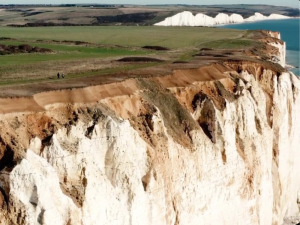
Photo by Chip Phillips (Chip Creative)
Writer Notes
This piece was originally written for use as a filmed poem responding to the archaeology of Seaford Head as part of the Seaford Head Archaeology Project.
A film about the project can be found here and further information about the project can be found here .
References
- Thanks to Seaford Museum for access to their archives, and to Adam Chugg, Town Clerk of Seaford Town Council, and Jon Sygrave, Archaeology South East.
- Notes on Deep Time (Helen Gordon).
-
From the Lighthouse by Alinah Azadeh
Listen to From the Lighthouse in full here (with audio captions):
You can also hear From the Lighthouse in the landscape that inspired it, owned and cared for by the National Trust. Access the visitor leaflet here.
What 3 Words:
https://w3w.co/line.arise.feed
Summary
The Belle Tout Lighthouse tells us of its many lives and dreams as it contemplates its last days on land.
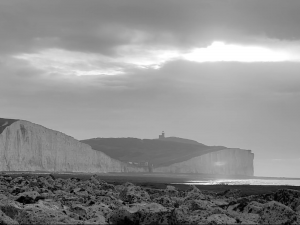
Writer Notes
A narrative poem told from the point of view of the Belle Tout lighthouse itself, questioning its own sense of purpose and vulnerability as it changes in form, position and use.
Interweaving its various real and imagined incarnations over the centuries, I explore our relationship to coastal landscape loss, and bring the south coast’s climate justice links to life, by including the overlooked links to the legacies of slavery in Sussex via a profile of Belle Tout’s first benefactor, ‘Mad Jack’ Fuller.
References
- The Story of Belle Tout Lighthouse (Rob Wassell)
- Belle Tout: The Little Lighthouse That Moved (Elizabeth Wright)
- Mad Jack: The Many Loves of John Fuller, Squire of Brightling (Annette Lloyd Thomas
- Fuller of Sussex – A Georgian Squire – Geoff Huthison
- John Fuller ‘Mad Jack’ – new research profile by Centre for the Study of the Legacies of British Slavery, University College London (see: Summary of Individual | Legacies of British Slavery (ucl.ac.uk)
-
Taking Root by Alinah Azadeh
Listen to Taking Root in full here (with audio captions):
You can also hear Taking Root in the landscape that inspired it, owned and cared for by Seven Sisters Country Park. Access the visitor leaflet here.
What 3 Words: https://w3w.co/boasted.hound.crunched
Summary
A search for rest, recovery and renewal as medieval history repeats itself near an abandoned village.
Writer Notes
Inspired by the history of Exceat village and church, my walks and talks with staff on climate, history and biodiversity and the Seven Sisters Country Park’s current renaturing process across the area.
References
The following references influenced the development of this piece:
- Quirky Sussex History (Kevin Gordon)
- Seven Sisters: The History Behind the View (Monty Larkin)
- Online archive articles on Exceat, the Black Death and other related history from: net, Historic England, International War Museum, Hampshire History,
- Braiding Sweetgrass (Robin Wall Kimmerer)
- Underland, A Deep Time Journey (Robert McFarlane)
-
The Fruit-Bearing Tree by Alinah Azadeh
Listen to The Fruit-Bearing Tree by Alinah Azadeh in full here (with audio captions):
You can also hear The Fruit-Bearing Tree in the landscape that inspired it, owned and cared for by the National Trust. Access the visitor leaflet here.
What 3 Words: https://what3words.com/erupt.recruited.condensed
Summary
A Spring walk to the middle of the Seven Sisters, sparks reflections on star constellations, land, climate and kinship.
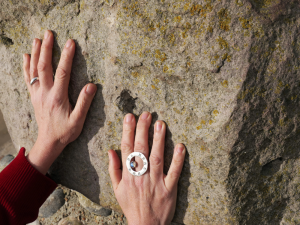
Photo by Bip Mistry
Writer Notes
Inspired by the shipwreck of the Coonatto, which is still visible at low tide just below Flagstaff Point.
Dedicated to my mother Parvin Azadeh Rieu and all the night writers. Thanks to Nikki Tomlinson and Graeme Miller for the Crowlink space and the chalk walk to visit the wreck.
References
The following references influenced the development of this piece:
- East Dean and Friston History Society pamphlets – various including on the Coonatto shipwreck.
- The Human Cosmos: A Secret History of the Stars (Jo Marchant)
- Songlines: Tracking the Seven Sisters (National Museum of Australia)
- Guardian article: The Killing Times – Frontier Wars (by Lorena Allam and Nick Evershed)
- The Rubaiyat (Omar Khayam)
To find out more about the Coonatto, visit the following sites:
- Blogpost from Quirky Sussex History by Kevin Gordon: The Sailor-Girl with a Rocky History (posted 21 February, 2022)
- Wikipedia: Coonatto (Clipper Ship)
-
Letters Home by Dulani Kulasinghe
Listen to Letters Home in full here (with audio captions):
You can also hear Letters Home in the landscape that inspired it, owned and cared for by Seaford Town Council and Sussex Wildlife Trust. Access the visitor leaflet here.
What 3 Words: https://w3w.co/cunning.smarting.spruced
Summary
A young man attends a World War I recruitment meeting in St Lucia and decides to enlist in the British West Indies Regiment with his friends.
They travel by ship to Britain and arrive in Seaford, where expectation and experience collide.
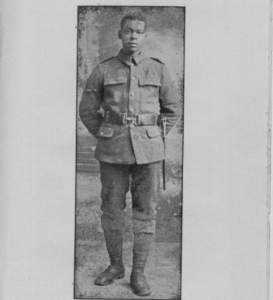
Writer Notes
This poem was inspired by two of the 19 Commonwealth war graves in Seaford cemetery belonging to Nelson and Dennis Février, cousins from St Lucia, and by finding the war diary of the 1st battalion of the British West Indies Regiment (digitised and freely available here).
The details that structure the poem – dates, numbers of men who sailed from each island, ship and place names – all come from the war diary.
Archival research at the Seaford Museum & Heritage Society and the work of David Olusoga have also helped to flesh out this story.
Though the central character is a mesh of my imaginings and this research, the piece is grounded in the lives of these Caribbean men, whose history is not widely enough known and celebrated.
References and credits
- I first encountered the story of Caribbean soldiers in Sussex through research for a joint HDMT Music / Strike-A Light project in summer 2018 (resulting in this booklet). Three years later, thanks to a bursary from Writing Our Legacy and South Downs National Park Authority, I was able to do further research and the writing which grew into this work for We Hear You Now.
- With thanks to Seaford Town Council and to Jenny Wistreich. Photo credit: AE Horner, From the Island of the Sea: the West Indian battalion in France (1919
-
Speaking Into Being – Landscape as Archive by Pauline Rutter
A walking landscape as archive essay by activist, academic and poet Pauline Rutter across the Sussex Heritage Coast inspired by the We Hear You Now audio walk series.
-
Footnotes by Sheila Auguste
The number 12 bus is the start of a journey for a healing walk in the Seven Sisters landscape.
You can explore these audio stories, new myths and poetry from home below, or discover the pieces out in the landscape via walks to listening points in the form of acrylic signs hosting QR codes and NFC tags across Seven Sisters Country Park and the wider Sussex Heritage Coast.
We Hear You Now Series Production Credits
- Lead Writer and curator : Alinah Azadeh
- Sound recording: Long Way Home Productions / Sonic Boom Audio
- Sound Design: Sonic Boom Audio / David Thomas
- Music: Dirk Campbell
- Film: Bip Mistry, Transition Film
- In partnership with South Downs National Park Authority
- Funded by: Arts Council England and the South Downs National Park Authority.
